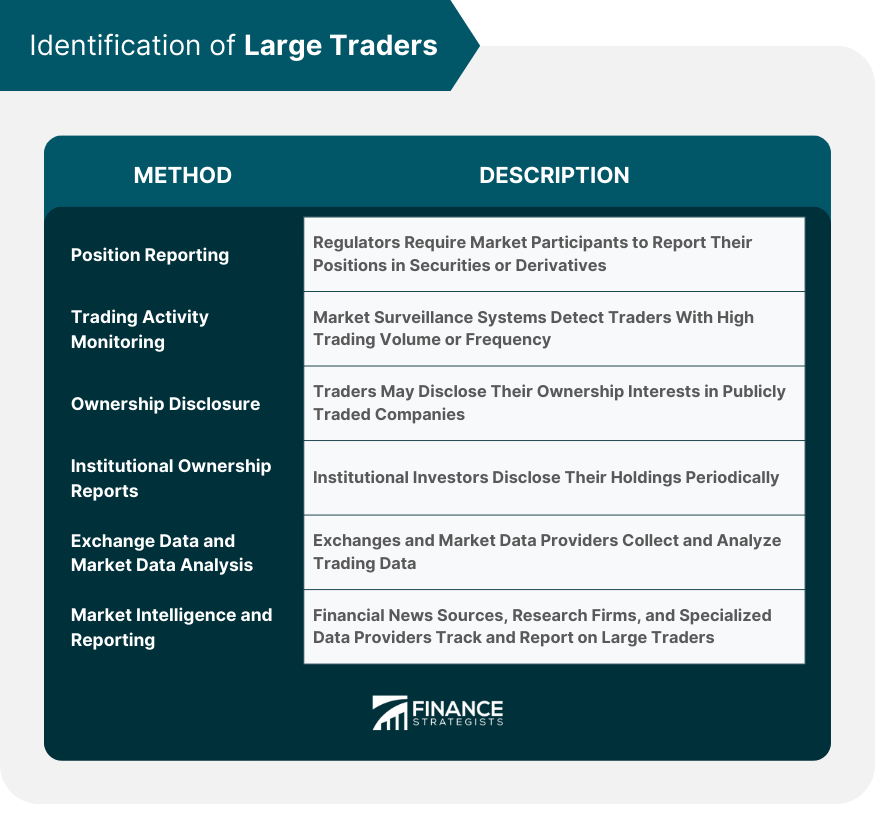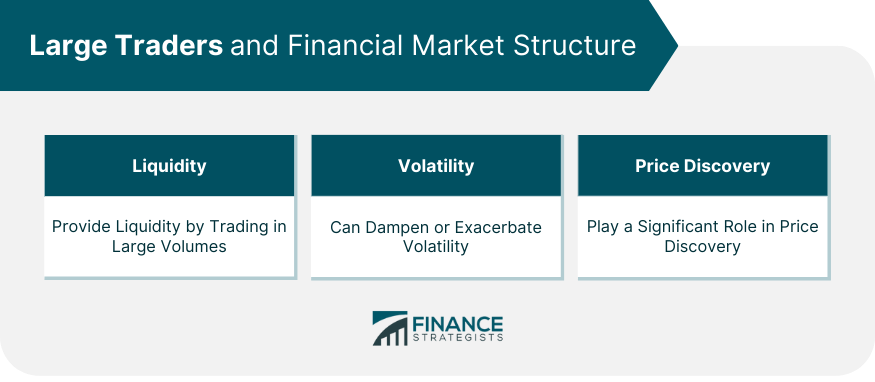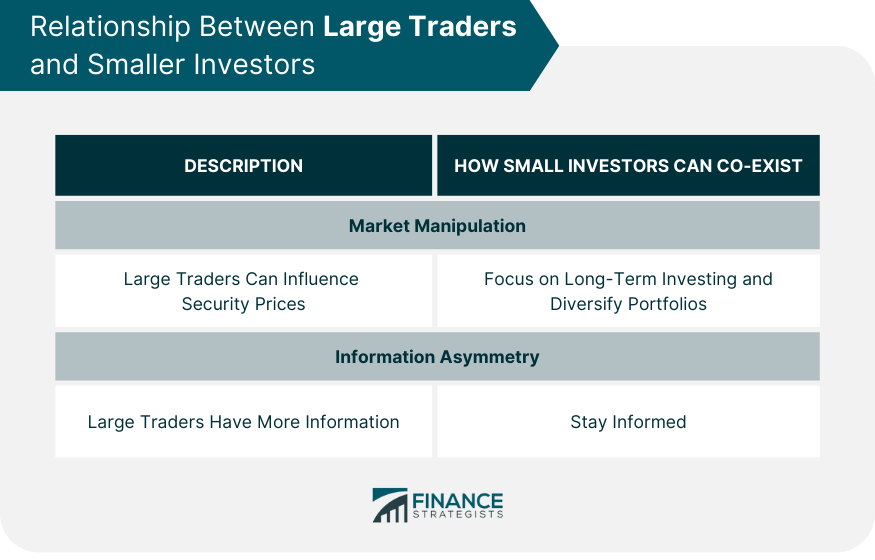Large traders, as defined by the U.S. Securities and Exchange Commission (SEC), are individuals, entities, or institutions that engage in significant trading activity in the financial market. According to the SEC's Rule 13h-1, a large trader is someone who buys or sells the same security, through one or more accounts, in an amount equal to or exceeding 2 million shares or $20 million in a single day, or 20 million shares or $200 million in a calendar month. These traders have the potential to impact market prices and liquidity due to the size and frequency of their transactions. The identification of large traders is important for market surveillance, ensuring transparency, and detecting potential market manipulation. Regulators and market participants monitor the activities of large traders to maintain market integrity and protect investors' interests. Large traders can be identified through various methods and criteria, including: Regulators may require market participants to report their positions in specific securities or derivatives. This reporting can help identify traders who hold significant positions and meet certain thresholds based on size or volume. By analyzing trading data and transaction records, market surveillance systems can detect traders with high trading volumes or frequency. Unusually large trades or patterns of trading activity can indicate the presence of a large trader. In some cases, large traders may be required to disclose their ownership interests in publicly traded companies. This can be done through regulatory filings or disclosures to relevant authorities. Institutional investors, such as mutual funds or pension funds, are typically required to disclose their holdings periodically. These reports can help identify large traders based on their ownership stakes. Exchanges and market data providers collect and analyze trading information, including order book data and trade execution data. By examining this data, market participants and regulators can identify traders who consistently engage in large or influential trading activity. Financial news sources, research firms, and specialized data providers may track and report on large traders based on their research and market intelligence. This information can provide insights into the activities of prominent market participants. It's important to note that the specific methods and criteria for identifying large traders may vary depending on regulatory requirements, market structure, and jurisdiction. Different markets and jurisdictions may have their own rules and reporting obligations for identifying and monitoring large traders. Large traders, by virtue of their substantial transactions, provide liquidity to the markets. This liquidity is the lifeblood of financial markets as it ensures the smooth operation of trading activities. It allows securities to be bought and sold easily without causing drastic price changes. However, large traders can also disrupt liquidity if they trade in large volumes and others are unwilling or unable to take the other side of the trade. Large traders can both dampen and exacerbate market volatility. On the one hand, by providing liquidity and contributing to price discovery, they can reduce volatility. On the other hand, their large trades, particularly when they are in the same direction, can increase volatility, at least temporarily. The net impact depends on various factors, including the nature of the large trader’s strategy, the level of market liquidity, and the overall market sentiment. Price discovery is the process through which the price of a security is determined by the supply and demand of buyers and sellers in the market. Large traders play a significant role in this process. Their trades, which often incorporate vast amounts of information, can lead to more accurate security prices. However, if large traders have monopolistic power, they can distort prices, leading to less efficient markets. The SEC has various rules and regulations for large traders. As mentioned, Rule 13h-1 requires large traders to identify themselves to the SEC. They must also keep records of all their transactions. The SEC uses this information to monitor the impact of large traders on the securities market and to investigate potential market abuses. Apart from the SEC, other regulatory bodies also impose rules that impact large traders. For example, the Financial Industry Regulatory Authority (FINRA) has rules on market manipulation, while the Commodity Futures Trading Commission (CFTC) has rules on position limits for futures contracts. Large traders must adhere to all relevant regulations, which can impact their trading strategies and operations. In addition to government regulators, Self-Regulatory Organizations (SROs) like FINRA and the various stock exchanges also play a role in overseeing large traders. They have their own rules and surveillance systems to monitor trading activities and enforce compliance. They can take disciplinary action against members for rule violations and refer serious matters to the SEC or other governmental authorities. The complexity and depth of large traders' impact on financial markets are profound. Their actions reverberate across the financial landscape, influencing everything from individual security prices to the overall stability of the financial system. Therefore, understanding large traders, their roles, and the regulations governing them is essential for anyone involved in the financial markets. One concern often voiced by smaller investors is the potential for large traders to manipulate markets. By placing substantial buy or sell orders, large traders can influence security prices, potentially to the detriment of smaller investors. While regulations are in place to prevent market manipulation, the risk cannot be entirely eliminated. Another issue is information asymmetry. Large traders often have access to more extensive and timely information than smaller investors. This advantage can enable them to make more informed trading decisions, potentially at the expense of smaller investors. Despite these challenges, small investors can co-exist with large traders. By focusing on long-term investing strategies, small investors can potentially avoid the short-term price fluctuations caused by large traders. Also, by diversifying their portfolios, they can reduce the risk of any single large trader significantly impacting their investments. Large traders are pivotal figures. By definition, large traders are individuals or entities that execute substantial transactions sufficiently large to influence the price and volatility of securities. They're identified through regulations, such as the SEC's Rule 13h-1, which mandates these market behemoths to self-identify, thereby contributing to market transparency and fairness. Their existence is a double-edged sword. On one side, large traders, through their hefty transactions, provide liquidity and aid in the critical process of price discovery. On the other side, their significant presence can raise concerns about market manipulation and information asymmetry, particularly for smaller investors navigating the same waters. However, smaller investors can successfully co-exist with large traders. Adopting a long-term investment strategy, focusing on diversification, and staying abreast of market trends can help them thrive in a financial landscape often influenced by the actions of large traders. Given the substantial influence and complexity surrounding large traders, professional guidance can be invaluable. What Are Large Traders?
Identification of Large Traders
Position Reporting
Trading Activity Monitoring
Ownership Disclosure
Institutional Ownership Reports
Exchange Data and Market Data Analysis
Market Intelligence and Reporting

Large Traders and Financial Market Structure
Impact of Large Traders on Market Liquidity
Large Traders and Market Volatility
Effect of Large Traders on Price Discovery

Regulatory Landscape for Large Traders
SEC Regulations for Large Traders
Other Relevant Financial Regulations Impacting Large Traders
Role of Self-Regulatory Organizations (SROs) in Overseeing Large Traders
Relationship Between Large Traders and Smaller Investors
Large Traders and Market Manipulation Concerns
Large Traders and Information Asymmetry
How Small Investors Can Co-exist With Large Traders

Final Thoughts
Large Traders FAQs
A large trader is an individual or entity that conducts substantial transactions in financial markets. The SEC defines a large trader as anyone who transacts equal to or greater than 2 million shares or $20 million during any calendar day or 20 million shares or $200 million during any calendar month.
The SEC has specific rules for large traders. For instance, Rule 13h-1 requires large traders to self-identify and provide detailed records of their transactions.
Large traders can both dampen and exacerbate market volatility. Their large trades can cause price fluctuations, but they also contribute to price discovery and liquidity, which can stabilize markets.
While large traders can influence markets in ways that may concern smaller investors, such as potential market manipulation and information asymmetry, small investors can co-exist with large traders by adopting long-term investing strategies and diversifying their portfolios.
Trends like globalization and technological innovations will continue to influence the role of large traders. They are likely to remain a significant force in financial markets, albeit with increased scrutiny from regulators and changing market dynamics due to technological innovations.
True Tamplin is a published author, public speaker, CEO of UpDigital, and founder of Finance Strategists.
True is a Certified Educator in Personal Finance (CEPF®), author of The Handy Financial Ratios Guide, a member of the Society for Advancing Business Editing and Writing, contributes to his financial education site, Finance Strategists, and has spoken to various financial communities such as the CFA Institute, as well as university students like his Alma mater, Biola University, where he received a bachelor of science in business and data analytics.
To learn more about True, visit his personal website or view his author profiles on Amazon, Nasdaq and Forbes.















